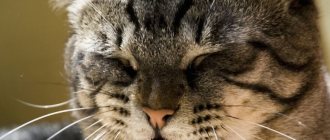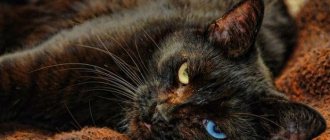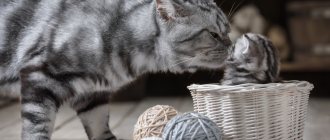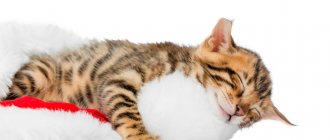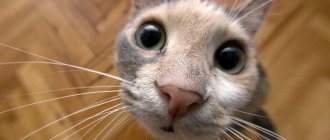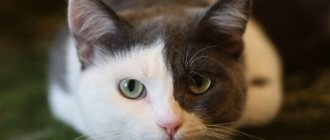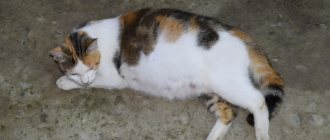Wheezing is wheezing and noisy breathing that accompanies most pathologies of the animal’s respiratory system. Wheezing occurs in cats for two reasons: due to narrowing of the airway lumen and due to foaming of fluid (exudate, transudate or blood) accumulating in the respiratory system.
They also say that a cat wheezes when the animal wheezes or loses its voice. This is a completely different problem. It occurs due to incomplete closure of the vocal cords as a result of catarrhal laryngitis and accumulation of mucus in the glottis.
Wheezing is not just one sound. This is a whole combination of noise, each option corresponds to a specific group of pathologies.
Wheezing is usually classified into:
- wet;
- dry;
- crepitant;
- whistling.
Wet wheezing sounds appear due to the accumulation of mucus (phlegm) in the bronchi of the cat. Sputum is produced in large quantities as a result of inflammatory processes affecting the bronchial tree. The air inhaled by the animal passes through the mucus, bubbles form, which then burst. This is what causes wheezing. Moist rales are divided into small-, medium-, and large-bubble.
The first accompany the collapse of small bubbles formed by sputum. May occur with pulmonary infarction or bronchopneumonia. The latter resemble the sound of air blown through a straw. They occur when there is hypersecretion of mucus as a result of bronchitis, fibrotic changes in the lungs or pneumosclerosis.
The latter type of wheezing is clearly audible even without a stethoscope and occurs due to the accumulation of exudate in the lungs with a weak cough reflex or pulmonary edema.
Dry noises are divided into whistling and buzzing. They arise due to narrowing of the lumen of the bronchi as a result of obstruction, mechanical compression by the tumor and the development of an allergic reaction. The air swirls and has difficulty squeezing through the narrow gap, which creates noise. When air passes through the unevenly narrowed bronchi, the sound becomes whistling. If there is viscous mucus in the bronchi, the mucous membranes block the path of air. And the breath passes with a slight buzzing sound, as if the air is squeezing through a narrow and half-covered hole.
What breathing is normal?
Normal breathing in a cat is a calm and uniform rise and fall of the chest, without jerks or convulsive movements. If a cat breathes from its stomach and sides, this means that the respiratory tract is impaired, and it is painful for the pet to breathe naturally. Worry should be caused by the appearance of wheezing or loss of voice.
If a cat wheezes, it means he is sick with something.
Note! If a cat wheezes quietly while breathing during sleep, and there are no convulsive sighs or wheezing, this is normal.
The main causes of whistling breathing
Wheezing in a cat may indicate the following diseases:
- Heart disease. If the breeder notices changes in the behavior and well-being of the pet, then you should pay attention to the characteristic color of the lips, tongue and gums. If a gray or even blue tint of the oral cavity is detected, we can conclude that the cardiovascular system is not coping with its work and the tissues are not receiving oxygen. In this situation, you should look for the cause in the malfunction of the main organ - the heart. The veterinarian must do a cardiogram, an x-ray examination, and take blood and urine tests. After receiving the data, establishes an accurate diagnosis and prescribes adequate treatment;
- Helminthiasis. If your cat wheezes and coughs, the cause may be the presence of parasites - lungworms that live in the cavity of the respiratory organ. In this case, it is very important to assess the scale of the problem. As a rule, helminths are amenable to systemic treatment. Doctors recommend antihelminthic drugs;
- Asthma. A disease in which the animal develops severe shortness of breath, while whistling and hoarse meowing are heard. At this moment, the pet experiences a severe lack of oxygen and begins to actively breathe. Swelling of the lung tissue is very dangerous, as it can cause death. During an asthma attack, it is very important to promptly give the animal special medications that can instantly relieve swelling and allow normal breathing. Treatment in this case is prescribed systematically, with regular visits to the veterinarian for examination;
- Heart disease. Wheezing in a cat can be a characteristic sign of a heart muscle defect. To establish a diagnosis, it is necessary to undergo a hardware examination in the clinic. At the initial stage of development of the pathology, the doctor prescribes maintenance therapy for stable heart function. In severe cases, surgery may be prescribed;
- Oncological disease. Growing tumors and tissue tumors can cause breathing problems. Whistles appear as a result of blockage of the airways. Special treatment is required, including opioid drugs that reduce pain. If the doctor determines that it is possible to remove the tumor, surgery will be scheduled.
The respiratory process directly depends on the physical and mental state of the cat. When you feel normal, breathing should be even, calm, and silent. When feeling unwell, the pet begins to actively and quickly inhale air, while wheezing and whistling are heard.
Signs of wheezing
The cat is coughing: why it wheezes, the reasons, as if it was choking
Wheezing is understood as noisy breathing, against the background of which a combination of many wheezing and whistling sounds is heard. Such deviation from normal breathing is a frequent companion to most pathologies of the animal’s respiratory tract.
Wheezing can occur for two reasons:
- in the process of narrowing the lumen of the respiratory tract;
- due to the accumulation and foaming of fluid in the respiratory system.
Noises and wheezing when breathing do not bode well
In addition, wheezing means a hoarse, strained voice or its complete absence. This pathology occurs due to incomplete closure of the vocal cords due to the accumulation of mucus in the glottis, which is a common symptom of many inflammatory processes.
The cat is breathing heavily and wheezing
Reasons that lead to loss of voice:
- Respiratory diseases are one of the common causes of wheezing when breathing in a cat. We are talking about various viral and infectious diseases that can be picked up by hypothermia in the cold season. It could be a cold or acute respiratory infection.
- Advanced respiratory diseases can lead to the development of pneumonia, viral feline rhinotracheitis, tonsillitis, calcivirosis or bronchial asthma, a common symptom of which is also loss of voice and wheezing.
- A foreign body in the larynx mechanically damages the surface of the pharynx due to the inability to swallow or regurgitate. This ultimately leads to the cat wheezing when he breathes. A pet can injure its throat with a thin or broken chicken bone, a tree branch, or choking on a spruce needle. Such damage is dangerous due to the high probability of a foreign object entering further into the digestive tract, injuring the upper respiratory tract and esophagus.
- Heart pathology. If the cat begins to show less activity, preferring to lie down instead of playing, walks slowly towards the bowl, as if overcoming obstacles, and upon reaching the goal, chokes, coughs or sneezes, this may be a sign of the development of heart pathologies. Often, owners are not even aware of the onset of heart problems in their cats due to the absence of symptoms. The disease develops, the body reaches a critical point, and after that symptoms appear and increase exponentially. A hoarse cat suffers from severe shortness of breath even after the slightest exertion. She has cold paw pads and ears, pallor of visible mucous membranes (gums, palate, eyes) due to poor blood circulation, in severe advanced cases, audible wheezing in the cat and bubbling in the chest, cold surface of the skin throughout the body.
The cat is trying to vomit a small object stuck in its throat
- Blood pathologies with a lack of iron in the body can also cause difficulty breathing with wheezing.
- With asthma, a cat wheezes and wheezes, presses to the floor, coughs, stretching its neck. As the disease progresses, severe shortness of breath and wheezing, even suffocation, appear.
- Pulmonary edema in a cat is an abnormal accumulation of fluid in the lungs, which is a consequence of various diseases of the internal organs and inflammatory processes. In this case, the cat wheezes when breathing with gurgling. He feels lethargic, phlegmatic, and desires to constantly sleep. The pet opens its mouth slightly with its tongue hanging out when breathing, inflating its belly and sides, trying to squeeze out liquid by coughing and swallowing; when coughing up, traces of blood, a bluish tint to the oral mucosa, and mucus from the nose may appear. A common urge of a cat is to expand its chest by standing in a position with its paws spread wide apart. Deterioration of the condition forces the cat to stretch out on its side.
- The accumulation of large amounts of fluid can be not only in the lungs, but also in the abdominal cavity. This pathology is called abdominal ascites, or dropsy. The pressure of the accumulated fluid compresses the internal organs, disrupting their activity. If dropsy is not treated in time, it can lead to the death of your pet.
Asthma can cause your cat to suffocate if you don't take action.
- The kitten wheezes when breathing with swelling of the larynx or laryngospasm, which appears due to poisoning with household chemicals. Such wheezing may be caused by an allergic reaction to tobacco smoke, dairy products, construction dust or strong odors.
- Oncology. From the second stage onwards, cancer is characterized by dysfunction of the respiratory system: the cat breathes heavily with wheezing, shortness of breath.
- Injuries due to improper handling by the owner, a fight with other cats, or an unsuccessful fall can cause damage to internal organs, including the respiratory system, so the cat may become hoarse.
- Tracheitis occurs due to many reasons: hypothermia, infection with a viral or bacterial pathogen, overdrying of the trachea during sleep during the heating season, evaporation of construction and paint materials. A strong barking cough and sore throat cause pain for the cat and cause loss of voice.
Helminthiasis
Extensive parasite infestation may explain why the cat grunts. Some types of worms develop in the lungs. By feeding on blood, tissues and multiplying in the respiratory tract, helminths provoke the occurrence of an inflammatory process and the formation of pathogenic microflora. As a result, the cat develops breathing problems accompanied by grunting.
In advanced stages, grunting and coughing result in vomiting, in which live parasites can be found. Treatment of pets with anthelmintic drugs should be carried out not only for therapeutic, but also for preventive purposes.
Diagnosis of the condition
The cat is breathing with its mouth open: what is the reason and what can be done
If the owner notices that the cat is breathing with difficulty, is very weak, apathetic and does not respond to anything, has severe injuries, has lost weight or has a serious illness (asthma, heart disease, etc.), it is necessary to urgently visit a veterinarian who has the necessary equipment and experience in providing assistance.
A weak, lethargic cat with trouble breathing should definitely be shown to a veterinary clinic.
During the trip, you need to check the cat’s breathing; if you can’t hear it, you can put a mirror against its nose or mouth. A foggy surface is evidence of breathing. You should also check the heartbeat in the chest and the pulse on the inside of the thigh. If breathing or heartbeat stops, you will have to start CPR yourself.
How to give artificial respiration to a cat
1. Place the animal on the floor. The neck and spine should form a straight line.
2. Clean the cat’s mouth from secretions with a napkin and close his mouth.
3. Place your palm in a tube, apply it to the animal’s nose, and exhale air there (you can inhale directly into the nose, covering the mouth with a handkerchief).
Frequency - approximately 20 times per minute for medium-sized cats (the smaller the pet, the more often). Monitor the intensity of exhalation so as not to damage the cat’s lungs (this is especially true for kittens). To do this, hold your hand on the cat's chest - with a suitable volume of air, it only expands slightly.
4. Feel your pulse every 20 seconds. If it suddenly stops, you need to try to restore the heartbeat with indirect massage. With one hand, take the cat's chest, pinching it between your thumb and the other four fingers, and quickly squeeze and release 5 times. After this, exhale 1 air into the cat’s nose, then squeeze again. Check every 2 minutes to see if there is a pulse. It is best to do this together, when one does massage and the other does artificial respiration. Continue until you regain your breathing or see a veterinarian.
The respiratory system of cats is naturally very vulnerable, so the only right thing to do if a cat is breathing heavily is to immediately take him to a veterinary clinic, where he will receive qualified assistance. Among the many diseases whose symptoms include shortness of breath, there are none that you can cure on your own.
The text of the article is subject to copyright. Copying of any part is possible only with the written permission of the authors of the Vetsystem project. Otherwise, use of the article will be considered a violation of the Law on Copyright and Related Rights. Some of the images are taken from open sources. If you are the author of the photo, we can provide a link to the authorship or remove the photo at your request.
Every cat owner is touched by the sounds made by his pet. What could be more charming than the snoring, smacking of your lips in your sleep, and even the snoring of a furry pet? However, you should not let your guard down, as some sounds, such as sniffling and grunting, may indicate the presence of serious illnesses. In what cases should measures be taken if a cat wheezes while breathing? Why might this happen?
The cat is choking and wheezing: what to do
Seizures in a cat: causes, what to do, treatment
You need to open the mouth and pull the tongue forward, check the throat for foreign objects that should be removed, including mucus or vomit. This will help clear your airways. To do this, hold the cat by its hind legs and raise its head.
Important! If you suspect a spinal injury, you should not lift or move the animal.
If removal of the foreign body does not help, you must begin first aid.
First aid for respiratory arrest
Step-by-step instruction:
How to give artificial respiration to a cat
- Start artificial respiration: lay the cat on its side, pull the tongue forward, cover the mouth with your hand and straighten the neck. Air is inhaled through the cat's nose every 3 seconds. It is important that the chest rises, but does not arch from excess inhaled air.
- During artificial respiration, you need to check for a heartbeat. If the heart is beating but there is no breathing, you need to inhale air at a rate of 10 breaths per minute until the cat breathes on its own.
- If you are completely sure of cardiac arrest, begin chest massage.
- If respiratory arrest is detected and resuscitation begins, it is important that someone call a veterinarian or take the cat and its owner to the clinic.
Important! Cardiopulmonary resuscitation should not be performed if the cat is conscious.
Instructions on how to perform chest compressions on a cat
Reasons for changes in respiratory rate in cats
1. Physiological reasons - a natural reaction of the body, which is the norm. It can be caused by:
- physical activity. In healthy animals, respiratory rate depends mainly on the level of physical activity. The calmest breathing in cats is during sleep;
- stress. When nervous, angry, or excited, the cat's breathing quickens. For example, while traveling in a car, when moving to a new place, during various medical procedures. This is a short-term phenomenon and goes away as soon as the source of stress disappears. In pregnant, giving birth, lactating and estrus cats, breathing also often noticeably increases, but this is not a cause for concern, since this is a normal reaction of the body to additional stress;
- overheating or hypothermia. When overheated, a cat breathes through its mouth, often and heavily. He tries to spread out his whole body on the coolest surface in the house - tiles, linoleum or under the bathtub. If the temperature in the room is too high, wet a towel with cold water and wrap it around your pet, or simply wet his ears and underbelly, and make sure he drinks enough. When hypothermia occurs, on the contrary, breathing is barely noticeable, the pet curls up into a ball, and the fur stands on end for better thermal insulation. In this case, wrap him in a warm blanket.
2. Pathological causes - caused by various diseases or abnormalities. Among them:
- injuries to the chest, spine and ribs. If your cat sticks out his tongue and breathes frequently, taking small, shallow breaths, then breathing may be causing him pain. He may try to hide away from everyone, walk carefully, as if his movements are constrained, and eat poorly. In this case, the animal must be carefully examined. If there are wounds, torn hair, or some areas of the body are extremely painful when touched, take him to the vet immediately;
- foreign body in the throat or nose. Look into the cat's throat. If you notice an object stuck in your larynx and making it difficult to breathe, try to remove it. If it doesn’t work the first time, go to the clinic immediately, otherwise repeated attempts can only push it deeper. If the cat wheezes when breathing through the nose, or a whistle is heard, then it seems that a foreign body is stuck in the nasal passage;
- deterioration of health due to the development of various diseases and pathologies. In such cases, a change in breathing rate is accompanied by other alarming symptoms - an increase or decrease in the cat’s body temperature, signs of dehydration, vomiting, coughing, discharge from the eyes and nose. Wheezing in the chest is a symptom of stagnation of fluid or mucus, which occurs with pneumonia or heart disease. When a cat breathes with his tongue hanging out, it is possible that the nasopharyngeal mucosa is so inflamed that breathing through the nose is almost impossible.
Therapeutic techniques
In the clinic, after clearing the airways, the veterinarian can start breathing using artificial respiration, inserting an endotracheal tube and connecting to a ventilator. An indirect cardiac massage, a defibrillator and injections of drugs (adrenaline, atropine, atipemazole, etc.) help a specialist to start a stopped heart. Depending on the results of resuscitation efforts, studies are prescribed to establish a diagnosis, treatment and further care.
Regular preventive examinations and tests will help identify diseases in the early stages, without leading them to a chronic form. If you have congenital or chronic diseases, you should follow your veterinarian's recommendations for caring for your cat. An attentive and caring owner will always notice suspicious symptoms and seek advice from a specialist, because the life and health of the cat is in his hands.
Treatment and prevention
It’s worth starting with observations and visual inspection. It will be the same for owners living in Moscow, St. Petersburg or absolutely any locality in our country. At some point, the cat stopped eating something, lost interest in toys, and did not respond to his name.
It is worth noting that snoring and even coughing are a normal state for a cat, especially during sleep. It's all about frequency. If problems are observed during the daytime with an enviable frequency (up to several times every 5 minutes), then you should contact a veterinarian.
What information might a specialist need? Firstly, the age and activity of the animal . Secondly, how long ago the wheezing began, and whether it is accompanied by other symptoms . For example, shortness of breath, heavy breathing, mucous or blood discharge.
Thirdly, the condition of the mucous membrane. Fourthly, what injuries did the pet receive, what operations did it undergo . Fifthly, how much the behavior of the hoarse cat has changed.
Based on the nature of the disease, the focus of the disease can be determined. For example, if the wheezing is wet, there is a large amount of mucus in the bronchi. Dry or whistling - swelling of the respiratory system. Cracking sounds are possible problems with the alveoli.
It is worth remembering that each case is individual, because there are a huge number of causes of the disease. Treatment for hoarse voice is prescribed by a veterinarian. The specialist usually prescribes an x-ray of the lower respiratory tract if necessary.
Using special instruments, he examines the nose and throat. During diagnosis, tracheal lavage may be prescribed . If a lot of fluid has accumulated in the pleural area, it is pumped out with a syringe. This often indicates heart failure. It is worth noting that the cause of an abundance of mucus can be drafts, high humidity, and constant stress.
ATTENTION! At home, strictly follow the veterinarian's instructions. Do not allow your pet to become hypothermic. Expectorants, antibiotics and drugs to support and restore immunity are often prescribed as medications. You can buy them at any veterinary pharmacy.
You should protect your pet from unnecessary contacts and remove other animals from the room (if there are any!). Provide peace, surround with care and affection.
Oncology
Among the causes, tumors should be specifically noted. They can be benign or cancerous, with metastases or not. Oncology often affects adult animals and is much less common than in dogs. A tumor can develop against the background of any disease, including respiratory diseases.
New growths of any form grow, exerting strong pressure. Wheezing occurs when the tumor has invaded any part of the respiratory tract. The tumor makes breathing significantly more difficult. If the tumor appears in or near the throat, the cat swallows heavily and wheezes when it breathes. At the same time, hoarseness of voice, squeaking, shortness of breath and coughing up blood appear.
In any case, when a cat is breathing heavily and this is accompanied by wheezing, the animal must be shown to a veterinarian. Basically, these are symptoms of a disease. A lack of air is also indicated when a cat sleeps with its mouth open. If animals have respiratory diseases, there should always be a bowl of clean water.
December 20th, 2020 , 08:30 pm
The other day I discovered an interesting feature of our Maine Coon
and in fact, now I understand why they are still called “catdogs”.
I used to think that the nickname “catdog”
was attached to them because of their size or, as some write, because of the dog’s devotion.
Honestly, I never found canine devotion in our Maine Coon. On the contrary, he loves many people and even gets along well with strangers. What kind of loyalty is there? It's more of a betrayal. All you have to do is entice him with meat - and the stranger immediately becomes a friend!
In general, from the dog habits in our Maine Coon Murcello (popularly Murchik), I noticed the following:
1. Constantly burying food
(This problem was partially solved by purchasing a dog bowl, which does not stand on the floor, but is kept at a height. True, the problem The spillage of food was not resolved, but the problem of the bowl turning over was resolved).
2.
around all the time
with an important look and his tail raised
, like a happy dog.
3. Grunts
like some dogs or piglets))) Yes, Maine Coons have a much louder purr (tractor) than ordinary cats. And if he sleeps, he sniffles or even snores like a human. You can hear it very loudly! We are already used to it, of course, but initially it was unusual. Ordinary cats sometimes snore, but this happens rarely and is barely audible. Our Maine Coon grunts like a pig.
4. When
greeting the owner at the entrance to the house
, I really don’t think this is a feature of Coons. All my cats met me and even saw me off...
5. Tests water and food with his paw.
I often notice that a cat tests the water with its paw to see if it is fresh. First, he puts his paw in the water, wets it and licks it, after that he just starts drinking. What if the water is not fresh? If the water is not fresh, the Maine Coon climbs into the sink and sits there until you pour clean water. The same thing with natural food (not with food, for example, salads, scrambled eggs, meat, sour cream - everything is tasted with the paw).
By the way, our Maine Coon can hold a fork and a spoon
with his paw
(holds it for 5-10 seconds), which dogs are unlikely to be able to do))) True, he doesn’t know how to use it, he just holds it))) Eh, I should teach him how to use cutlery)
And here is the 6th feature
I discovered it not long ago and was very surprised! Maybe some who have never owned a Maine Coon will even think that I'm lying. Because when I told my husband and friends about this, many doubted it (including my husband), so I even had to show it. She proved this to her husband, but, alas, to her friends (((In front of strangers, the cat refused to do it.
6.
Runs for a stick and brings it back to the owner
.
It's hard to believe, I know, but it's really true!!! True, the stick is not a dog stick, but... an ear stick
!!!
Our Murchik loves to play with anything long and one of his favorite toys is an ear stick
. I noticed this quite recently - the Maine Coon began to turn over the trash can (for paper waste) in my daughter’s room and pull out these cotton swabs. After that, I noticed that when the cat saw the ear stick, his eyes sharpened, and he began to “demand” to be played with.
One night, while I was watching a TV series, the Maine Coon pulled a cotton swab out of the bucket and brought it to my bed, almost giving it to me. At first I thought: “What should I do with her?” I decided to throw it on the floor and the cat immediately rushed after it. After “rolling” it a little on the floor with his paws, he grabbed it with his mouth and brought it back to me. Throwing the stick on the floor again, the cat brought it back to me again. Now we play this game with him with these sticks, only now, clean)))
I'm thinking of training him to use a dog stick and making a video. I haven’t filmed this whole process yet, how we play with sticks, but I’ll do it later.
This is truly nonsense, which proves the unusualness of the Maine Coon
and its
resemblance to dogs
.
Why do you think Maine Coons are called “cotops”?
Who has Coons - tell me, do they play with sticks and bring them back, like a dog?
Cats cause endless affection to their owners. This is especially true for the sounds sometimes made by pets - snoring, sighing and even snoring. After all, they are different from ours and seem charming when made by a furry pet. But if the cat wheezes when he breathes constantly, this causes concern and anxiety.
Why does a cat sniffle when breathing?
A cat's wheezing and snoring indicate abnormalities in its body. They can be caused both by the characteristics of the breed and congenital pathologies, and by various diseases. If such symptoms occur, it is necessary to examine your pet. If there are no signs of deterioration in health, there is no reason to panic. If general malaise and other symptoms appear, the animal should be taken to a veterinarian.
Owners sometimes notice that their pet snores in his sleep, and when awake, his breathing seems labored, with hoarseness or wheezing. There are many reasons for this phenomenon, from the most harmless to the potentially fatal.
The structure of a cat's respiratory system is similar to that of a human. Between the nose and the lungs are the nasopharynx, bronchi and trachea. Breathing provides the entire body with oxygen and ventilation of the lungs from waste gases. If atypical sounds are observed during this process, it is necessary to show the animal to a veterinarian.
Impaired respiratory functions can be caused by causes that are not directly related to diseases that have pulmonary pathogenesis (edema, fibrosis, pneumonia), but are no less dangerous for the pet’s life. Failure of gas exchange in the body can be caused by:
- brain and spinal cord injuries;
- an inflammatory process affecting the central nervous system;
- heart failure;
- foreign objects caught in the nasopharynx.
Associated symptoms of a serious illness will be changes in the animal’s behavior:
- passivity;
- loss of appetite;
- purulent or foamy discharge from the nose and mouth when breathing;
- pale blueness of the mucous membrane.
Contacting a veterinarian is mandatory and urgent.
When a kitten, cat or cat sniffles, but does not show signs of pain, behaves naturally, plays, and does not lose appetite, it is worth conducting an accessible examination of the animal:
- 1. If the pet’s mucous membrane has a healthy pinkish color, the body does not lack oxygen.
- 2. The absence of nasal discharge excludes colds.
- 3. Light pressure along the entire length of the back will help determine the presence (absence) of areas of pain.
Hoarse breathing can be caused by a deviated nasal septum or obesity, which is no more dangerous for a cat than for a person.
If your pet is wheezing, scratching, or sneezing, the disorder may be caused by an allergic reaction. This condition develops in pets due to:
- household chemicals;
- synthetic materials (flooring, wall decoration);
- stern;
- mineral toilet filler.
In this case, it is necessary to isolate the animal from the allergen. Antihistamines can be used, but should not be overused.
In short-faced exotic cats, snoring is caused by physical features, that is, a short nose. Exotics and their crossbreeds are also characterized by a heart muscle defect.
What to do if home treatment does not help
If all of the above actions do not correct the situation, and your pet continues to wheeze, cough and sneeze, you should immediately visit the veterinary clinic with him. Only a professional can diagnose, take tests and examine the internal organs of the animal.
Treatment depends on the diagnosis. One of the worst options can be bronchial asthma, as it sometimes has to be treated throughout the animal's life. Asthma manifests itself in a certain season - most often in summer and autumn. In such cases, medications should be given before possible symptoms occur, so that the cat does not lie on the floor, stretch its neck, or cough.
Reasons why a rabbit grunts when breathing through its nose
Sometimes pets produce unusual sounds, and they alarm a person who is far from veterinary medicine, since he does not quite understand the reasons that prompt the animal to make them.
The rabbit is a rather silent animal, but sometimes the sounds it produces resemble grunting.
Why does the rabbit grunt?
The behavior and habits of a decorative animal are no different from an ordinary rabbit. This animal has a genetic fear of being discovered by a predator, and therefore sound communication is kept to a minimum. There may be several reasons why a rabbit grunts:
- an uncastrated animal grunts, wanting to mate;
- shows dissatisfaction;
- dental problems;
- eye and heart diseases;
- runny nose;
- pneumonia.
If the grunting does not stop for a certain time, then it is better to show the animal to a specialist.
Did you know? In the wild, the life expectancy of a rabbit rarely exceeds one year, while at home the animal lives up to 8–12 years of age.
Expresses dissatisfaction
It’s not at all difficult to cause a rabbit’s dissatisfaction: you picked him up wrong, you held him wrong, you picked him up without his consent. He may be dissatisfied with the environment, not accept something or someone new.
Often a demonstration of irritation and dissatisfaction can be seen when trying to touch an animal. A dissatisfied rabbit's ears are pressed tightly to the head and back, and the head seems to be pulled into the body, the posture is tense - the animal visually shrinks. With all its appearance it speaks of its inflated state and stress. If you want to pet the animal, then give it time to calm down.
Dental problems
When the teeth do not have time to grind down, improper growth of the incisors begins, which injure the oral cavity and cause pain to the rabbit.
Article on the topic: Strawberry diseases: prevention, signs and treatment
Dental problems often arise for the following reasons:
- improper diet. Often the desire to follow the path of least resistance leads to problems - abuse of dry store-bought mixtures, which are very nutritious, but do not contain fiber;
- suffered trauma , as a result of which the jaw bones fused incorrectly and the animal’s bite changed;
- lack of calcium in the body provokes weakening of teeth and discomfort when chewing food;
- genetic predisposition.
Did you know? The rabbit has 28 teeth, and in the upper jaw, behind the large front incisors, there is a second, small pair of incisors.
Runny nose
Inflammation of the nasal mucosa occurs in rabbits of any age; with excessive swelling of the mucous membrane, the animal begins to breathe through the mouth, making grunting sounds.
The reasons why a runny nose appears are:
- injury to the nasal mucosa, consumption of stale, moldy food;
- inhalation of hot air, the presence of dust and gases in it;
- infectious diseases.
Find out what and how to treat runny nose in rabbits.
Eye and heart diseases
Eye diseases cause a depressed state in the animal, in which there is no appetite. The animal tries to hide in a quiet corner, does not open its eyes or opens them with noticeable difficulty. Often eye diseases are accompanied by lacrimation and inflammation of the eyelids. Eye disease can be caused by the following reasons:
- injuries (scratches, blows), debris, food particles, insects getting into the eye;
- contact with the eyes of cosmetics or disinfectants that cause irritation of the mucous membranes;
- bacterial or viral infections;
- vitamin deficiency of the animal due to malnutrition;
- inflammation brought from other parts of the body.
Article on the topic: Main types of headers and their characteristics
Eye diseases, like others, need to be treated; you should not hope that they will go away on their own. The faster you react to a disease, the easier it is to cure it.
It will also be useful for you to know what diseases exist and how to treat them in rabbits.
Untreated diseases can provoke heart problems in a rabbit, causing heart failure, which manifests itself in the behavior of the animal. The animal develops apathy, a desire to hide, there is a loss of appetite, intermittent breathing, the mouth is constantly open, and uncharacteristic sounds appear.
If one or more symptoms appear, you should contact your veterinarian who will prescribe a course of treatment.
Preventive measures
Problems that arise with rabbit teeth are easier to prevent than to treat. Caring for incisor teeth is not difficult, but it requires certain actions:
- examination of the animal’s teeth and oral cavity at least once every two weeks, so as not to miss the development of the disease;
- a balanced diet that combines the presence of succulent and roughage;
- injury prevention.
Important! It is not hard food that wears teeth down, but the chewing process itself.
Prevention of respiratory diseases is the observance of veterinary and sanitary standards when keeping animals, timely cleaning and disinfection of the premises where the animal is kept. It is necessary to quickly respond to the occurrence of poor health of the animal and immediately eliminate the reason why the disease may develop.
A sick rabbit is placed in a dry and warm room with good air ventilation, given nutritious (dust-free) food, and the necessary manipulations are performed as prescribed by the veterinarian.
If it is discovered or suspected that an animal has become infected with an eye disease, it must be isolated from the herd in order to observe it individually and prevent infection of other rabbits.
A sick rabbit's eyes are washed with boric acid and instilled with eye drops prescribed by a veterinarian.
Article on the topic: Care and pruning of a columnar apple tree
Attentive and careful attitude, high-quality care will make your rabbits cheerful and healthy.
Source: https://sampit.ru/prichiny-po-kotorym-krolik-hryukaet-kogda-dyshit-nosom/

